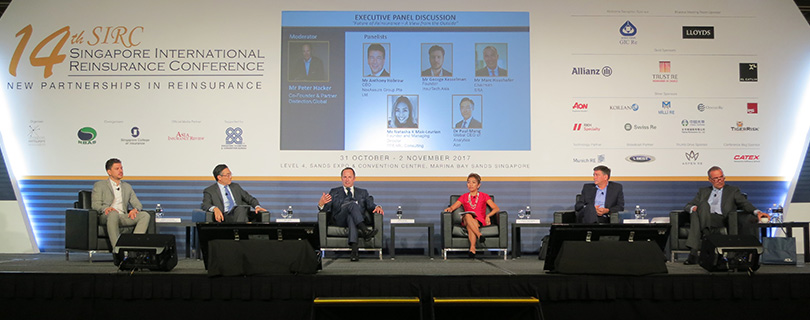New insurer/reinsurer roles morphing into one

New models of reinsurers and insurers will emerge in the not too distant future, with the lines between them blurring as interconnectedness grows both within the insurance sector and outside it, said speakers at a panel discussion held at the SIRC yesterday.
Pointing out that there will be more consolidation of the roles of these players, Mr George Kesselman, founder of InsurTech Asia, said: “We will see a ‘hybrid’ period of quasi insurers/reinsurers, which will be more general in their roles, consume less value and which may take the shape of a multi-role entity.”
He said that reinsurers will move closer to the forefront of risks, and engage more at the distribution level, together with startups and new players. “Rather than wait for someone to send the risks to you, they would ask, how do you enable (covering) new types of risks?”
Another panelist, Mr Anthony Hobrow, CEO of consultancy NexAssure Group, expressed optimism that the business pie in this new environment is not shrinking, but will instead continue to grow. The trend is one of merely shifting the balance of growth from the West to the Africa and Asia, where insurance penetration is low and the industry has a less strong presence. “Risks are increasing, they are also just getting more technical,” he added.
Age of machines

A fundamental shift that the industry will need to get used to is that the focus of insurance, such as motor, will shift from human error to machine error and technology-focused people will be the ones driving change, said Mr Hobrow. For instance, in motor, insurance will shift from driver to manufacturer. Operations, processes and legal contracts will be automated, and insurance wordings will be prepared via artificial intelligence.
He noted that in tandem, the skill base that is required within an insurance organisation will shift enormously too--and not just at a junior level. ‘How many people in the boardroom really understand blockchain?” he asked, citing the challenges.
Talent
The exponential increase in data being collected means that there is a need to build talent in the Big Data domain, said Ms Natasha K Mak-Levrion, Founder and Managing Director of PPEARL Consulting, who was also a panel speaker.
She said that the (re)insurance industry will be looking out for computational thinking skills to make meaning of such vast amounts of data efficiently, with a view to shift “from insight to foresight”. The workforce will also shift from a mainly transactional nature to advisory functions, where the opportunities will be much greater.
“Providing solutions, not just products, will be the key differentiator,” she said. She added that the industry needs too to look at the needs of the millennial generation, including their need for speed and work-life balance.
Other speakers including Mr Marc Haushofer, Chairman of Singapore Reinsurers’ Association, held the view that the industry needed to diversify not just by recruiting young people, but also those who are not too close to the business of insurance.
“They should ask questions that we as insiders, would not. It's really important that we learn to reduce the tradition of hierarchy, and bring in people who will challenge us,” he said.
Role of intermediaries and new trusted partnerships
As an insurance insider on the panel, Mr Paul Mang, Global CEO of Analytics at Aon, shared Ms Levrion's view that advisory would rise, and that would apply to brokers too. Going forward, they would play the role of trusted advisors structuring solutions, not just making placements.
Still, this would build upon their traditional role of bringing together capital and exposure, which would still exist. He added that emerging risks are complicated and may require new partnerships to be formed among insurers.

New client expectations and mindsets
As urbanisation and development progress, Mr Mang said that the concepts of not just risks, but also volatility are changing, and so are people's expectations of what is tolerable to them.
Margins of error are narrowing, while people also expect to live healthy and productive lives well into their 60s and 70s. The nature of interconnectedness has also led to new complexities and the need for analytics and new capabilities to address them.
Mr Kesselman cited the example of Uber, which had found it challenging to find an insurance industry player willing to offer a solution adapted to its business model until it finally found a partner in Aon. He said that the (re)insurance industry needs to change its mindset. It should not just look into selling products off-the-shelf, but should enter into partnerships and new collaborations in order to address new emerging fundamental risks.
He noted, however, that there will be an optimisation phase first in the coming years where manual processes would take time to move to digital ones, so that the efficiencies that the industry has to offer could be ‘unlocked’ as the sector makes a significant ”step change” to such an era.
The panel discussion was moderated by Mr Peter Hacker.
The three-day 14th SIRC ended yesterday. With the SIRC turned into an annual event from this year and next taking place from 30 October - 1 November 2018, the East Asian Insurance Congress will be held in Manila from 6–9 May 2018 instead of its customary calendar slot late in the year.